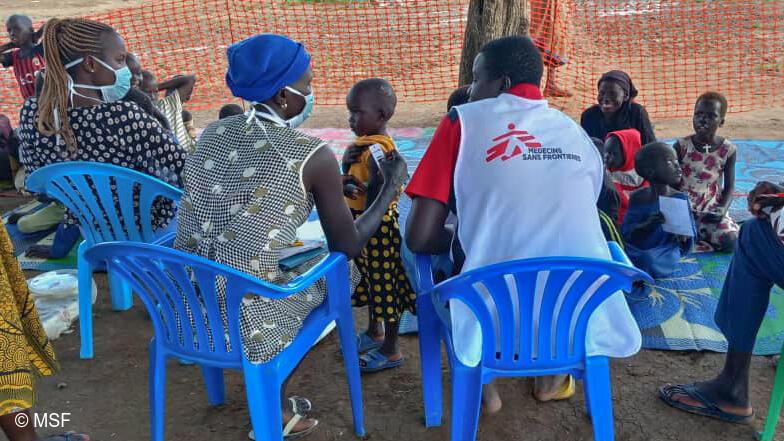Malaria is endemic in all parts of South Sudan with the entire population at risk of infection. The country experiences year-round transmission with peaks towards the end of the rainy season traditionally from around July to November. Transmission is higher in the southern parts of the country compared with the northern parts, as the disease accounts for over 60 percent of all health facility visits and is the leading cause of illness and death in children under five years.
Since June this year, the MSF team in South Sudan launched a significant activity in Twic County in Warrap state: a mass malaria drug administration campaign aimed at preventing the widespread morbidity and mortality caused by malaria. This campaign of three rounds, saw MSF working in close collaboration with the Ministry of Health and local communities, with an aim to reach over 14,000 individuals spread across six displacement camps.
Mohamed Ahmed, MSF Project Coordinator for the Twic Project, illustrates the campaign's specifics, its reach, and the feedback from the community.
Can you provide more details about the Malaria Mass Drug Administration campaign, including its objectives, the locations it covered, and the target people?
Malaria Mass Drug Administration (MDA) is a campaign designed to provide malaria drugs to the most vulnerable population in Twic County. The campaign involves administering 2-4 doses of anti-malaria drugs at various intervals throughout the malaria season.
The primary objective is to reduce the malaria disease burden by disrupting the transmission cycle and managing the surge of cases from June to December—a period during which malaria infections and related deaths typically peak in Twic County.
The campaign's primary focus is on children aged between 3 months and 15 years living in six camps for displaced persons, as they are the most vulnerable to increased malaria cases.
MSF collaborated closely with the Ministry of Health at both national and state levels to obtain the necessary permissions. A memorandum of understanding was signed to guide this joint effort. At the state and county levels, the Ministry of Health provides volunteers and staff, including a mobilization team, while MSF provides resources and technical expertise. All teams receive training from MSF staff before initiating the campaign.
Feedback from the communities within the displaced camps has been positive. In fact, during all three rounds of the campaign, teams registered and reached more individuals than initially targeted, indicating strong community acceptance.
Malaria Mass Drug Administration campaign in Twic, running from June to September.
The most recent round concluded in September. How did the MSF teams coordinate and manage the outreach across the six IDP camps logistically?
The MDA campaign aimed to serve over 14,000 persons in six internally displaced camps. The strategy involved:
- Assembling and mobilizing a multi-disciplinary team consisting of paramedical staff, health promoters, supervisors, and logistics personnel.
- Training these teams on the overarching strategy and the technical nuances of mass drug administration.
- Drafting a detailed chronogram and plan for the campaign's cycles.
Each MDA round extended over 10 days, comprising site preparation, planning, training, community mapping, registration, and drug administration.
After each day, debriefings were held to discuss challenges and strategize for the subsequent day.
What follow-up mechanisms are in place to assess the impact and efficacy of the drug administration in reducing malaria morbidity and mortality?
Community mapping and registration proved vital for the campaign's success. This process allowed MSF's health promotion team to communicate the strategy's objectives to community leaders and the targeted population.
Each household received a unique registration number, facilitating follow-up, direct observation of medication intake, and the recording of any potential side effects from the drug administration.
A post-campaign survey and impact assessment are scheduled in Twic to evaluate the campaign's impact. Notably, there has been a marked decline in hospitalization and deaths due to malaria in Mayen Abun Hospital, especially among the MDA target group, compared to figures from 2022.
Waiting room for the outpatient consultations in the MSF-supported Maye-Abun clinic. Morning is the busiest time in this area.
Speaking of community leaders, what kind of feedback or needs have been collected from the communities?
The feedback from the community has been positive. Displaced people have reported a decrease in malaria infections among children who received the drugs. A post-campaign assessment aims to gather more detailed feedback from the target groups, with results anticipated to provide a comprehensive answer to this question.
Lastly, how did MSF strategize its health promotion efforts to raise awareness about this initiative in the IDP camps to ensure widespread participation?
The health promotion strategy encompassed:
- Meetings with community leaders, local authorities, and youth and women representatives through coordination with Relief and Rehabilitation Commission (RRC)—a governmental body that serves as a bridge between communities and NGOs.
- Community awareness sessions, mapping, and registration: Boma healthcare workers, supervised by community health educators from both the Ministry of Health and MSF, conducted house-to-house visits in the six displaced camps, identifying, registering, and providing targeted beneficiaries with access cards.
- On drug administration days, the health promotion team engaged in house-to-house awareness campaigns, traced missing children, identified children with adverse reactions, and reported these incidents for proper management.
In the Warrap state, where there is a critical shortage of food, water, and healthcare services and where recurrent disease outbreaks are common, displaced families are grappling with an increasingly dire situation. This is further compounded by floods that have swept the western side of the county.
Operating there since March 2022, we've been offering humanitarian and medical aid to the displaced persons in Twic County. In the past, our teams distributed essential relief items like food, shelter, preventive and reactive measles vaccination campaigns and more. We've also constructed latrines and established water points in six out of the seven temporary camps.
Currently, about 30,000 people continue to endure harsh living conditions in these camps. Through our patients, our teams have first-hand witnessed the harrowing repercussions of both violence and displacement.
